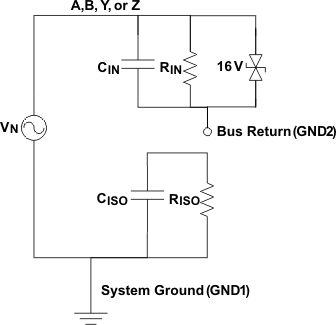ZHCSSZ4H October 2010 – August 2023 ISO1176T
PRODUCTION DATA
- 1
- 1 特性
- 2 应用
- 3 说明
- 4 Revision History
- 5 Pin Configuration and Functions
-
6 Specifications
- 6.1 Absolute Maximum Ratings
- 6.2 ESD Ratings
- 6.3 Recommended Operating Conditions
- 6.4 Thermal Information
- 6.5 Power Ratings
- 6.6 Insulation Specifications
- 6.7 Safety-Related Certifications
- 6.8 Safety Limiting Values
- 6.9 Electrical Characteristics: ISODE-Pin
- 6.10 Electrical Characteristics: Driver
- 6.11 Electrical Characteristics: Receiver
- 6.12 Supply Current
- 6.13 Transformer Driver Characteristics
- 6.14 Switching Characteristics: Driver
- 6.15 Switching Characteristics: Receiver
- 6.16 Insulation Characteristics Curves
- 6.17 Typical Characteristics
- 7 Parameter Measurement Information
- 8 Detailed Description
- 9 Application and Implementation
- 10Power Supply Recommendations
- 11Layout
- 12Device and Documentation Support
- 13Mechanical, Packaging, and Orderable Information
9.2.2.1.1
Isolation of a circuit insulates it from other circuits and earth so that noise develops across the insulation rather than circuit components. The most common noise threat to data-line circuits is voltage surges or electrical fast transients that occur after installation and the transient ratings of ISO1176T are sufficient for all but the most severe installations. However, some equipment manufacturers use their ESD generators to test transient susceptibility of their equipment and can exceed insulation ratings. ESD generators simulate static discharges that may occur during device or equipment handling with low-energy but high voltage transients.
Figure 9-3 models the ISO1176T bus IO connected to a noise generator. CIN and RIN is the device and any other stray or added capacitance or resistance across the A or B pin to GND2, CISO and RISO is the capacitance and resistance between GND1 and GND2 of ISO1176T plus those of any other insulation (transformer, or similar), and we assume stray inductance negligible. From this model, the voltage at the isolated bus return is shown in Equation 1:

and will always be less than 16 V from VN. If ISO1176T is tested as a stand-alone device, RIN = 6 × 104Ω, CIN = 16 × 10-12 F, RISO = 109Ω and CISO = 10-12 F.
Note from Figure 9-3 that the resistor ratio determines the voltage ratio at low frequency and it is the inverse capacitance ratio at high frequency. In the stand-alone case and for low frequency, as shown in Equation 2,

or essentially all of noise appears across the barrier. At high frequency, as shown in Equation 3,

and 94% of VN appears across the barrier. As long as RISO is greater than RIN and CISO is less than CIN, most of transient noise appears across the isolation barrier, as it should.
We recommend the reader not test equipment transient susceptibility with ESD generators or consider product claims of ESD ratings above the barrier transient ratings of an isolated interface. ESD is best managed through recessing or covering connector pins in a conductive connector shell and installer training.
 Figure 9-3 Noise Model
Figure 9-3 Noise Model